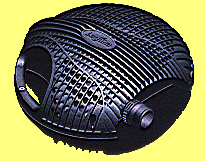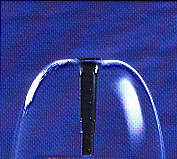



WATERFALLS
Waterfalls can be made from natural or re-constituted rock sections, fibre-glass sections obtained from good Garden Centres.
Alternatively, you can construct one yourself by using overlapping sections of liner. Here are a few tips:
Keep the lip of each fall level to produce an even curtain.
Dish the area behind the lip to form a small pool so that the waterfall does not dry out if turned off.
Partially fill these pools with clean pea gravel, this will help hold the water -
and also provide a better visual effect.
The higher the starting point of the fall and wider the fall lips the bigger the pump needed to effect a display.
If you intend to make a waterfall, first calculate how much water you need pumped to the top of the fall to achieve the desired effect and ensure that the pump will produce this (see PUMP FLOW RATE below).
However, the flow rate of pumps have quite a reduction of flow the higher the outlet is raised above the pump.
STREAMS
A stream can also be constructed from fibreglass sections, again obtained from good Garden Centres or by overlapping sections of liner.
Natural rock or re-constituted rock can be used along the sides with smaller pieces in the stream itself.
Cover the bottom of the stream with clean pea gravel, this will help hold the water, form an anchorage for plants as well as adding a natural look to the stream.
Do not make the stream too steep, a slope of 1 in 20 with one or two 50mm falls will suffice.
PUMP FLOW RATE
To calculate the pump required measure the lip of the widest fall.
The pump must be capable of producing a litre of water a minute for every 50mm of the widest lip.
When calculating a pump's flow one must take into consideration the 'head height.' This is the vertical height water has to be lifted above the pond's surface level and, in some circumstances, the length of the hose used to transport the water may also be a factor. There is a considerable reduction of water pumped the higher the outlet.
Take as a typical example a Hagen "Powerjet Maxflo 3500" pump.

With a head of 600mm this pump is rated to deliver approximately 2800 litres per hour (LPH).
Doubling the head height to 1200mm, delivery drops to 1640 LPH and at 1800mm it reduces even further to 240 LPH.
With smooth tubing up to 22mm allow a loss of 5 LPH for every 3 metres of tube from pump to outlet - and double that for tube sized 28mm to 42mm.
FOUNTAINS
There are three basic fountain types, Bells, Plumes (or Foamers) and Sprays.
Bells and Sprays appear to be the most popular.
Bell Fountains
 The pump and head of a Bell Fountain must be level or the 'bell' will not form uniformly.
The pump and head of a Bell Fountain must be level or the 'bell' will not form uniformly.
It may also be necessary to raise the pump in the pond.
Do not use soft bricks or porous blocks. Use hard engineering bricks or weathered concrete blocks.
Plume (or Foam) Fountains
 Plume or foaming fountains are very beneficial if fish are present as they ensure a good interchange of gases with the air, dispersing ammonia and nitrogen and taking up oxygen.
Plume or foaming fountains are very beneficial if fish are present as they ensure a good interchange of gases with the air, dispersing ammonia and nitrogen and taking up oxygen.
However the fish become used to the high level of oxygen.
The jet height should not be more than half the diameter of the pond, and in a windy position no more than a quarter, or splashing will result beyond the pond.
It may also be necessary to raise the pump in the pond. Do not use soft bricks or porous blocks. Use hard engineering bricks or weathered concrete blocks.
Sprays
 Spray Fountains produce either a single jet, a column made up of several jets or a multi-tiered spray display depending on the number of jets or holes in the head and their configuration. These also have some value in the interchange of gases with the air, dispersing ammonia and nitrogen and taking up oxygen.
Spray Fountains produce either a single jet, a column made up of several jets or a multi-tiered spray display depending on the number of jets or holes in the head and their configuration. These also have some value in the interchange of gases with the air, dispersing ammonia and nitrogen and taking up oxygen.
The jet height should not be more than half the diameter of the pond, and in a windy position no more than a quarter or splashing will result beyond the pond.
It may also be necessary to raise the pump in the pond. Do not use soft bricks or porous blocks. Use hard engineering bricks or weathered concrete blocks.
POND LIGHTING
 Lighting a pond at night can really set it off, especially if there is a spray or foam fountain in use. Lighting can be either above or below the depending on your choice.
Lighting a pond at night can really set it off, especially if there is a spray or foam fountain in use. Lighting can be either above or below the depending on your choice.
A mixture of surface and submerged coloured lighting can be used to produce quite startling effects, particularly if the pond is the centrepiece of a well laid out rockery.
Pond lighting has undergone a transformation in recent years with the development of 'safe' low voltage lighting kits. These take the danger out of using (and safeguarding) electricity in the water garden. Little harm will come to those accidentally cutting through a low voltage cable run to the pondside as the risk of an electric shock is minimal.
It may be possible soon to have efficient lighting (and perhaps even pond pumps) using solar power - if only our climate allowed enough hours of sunshine for its dependable use!
© FBAS 2004 RCM/RDE Pond Care Sheet 3 1/1
Return to POND CARE SHEETS INDEX
FISH CARE SHEETS INDEX
AQUARIUM MANAGEMENT CARE SHEETS INDEX
Last updated July, 2005